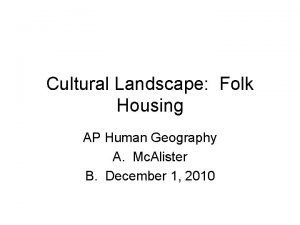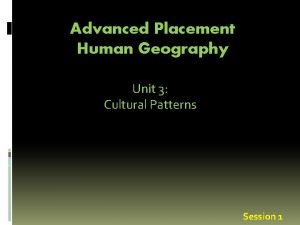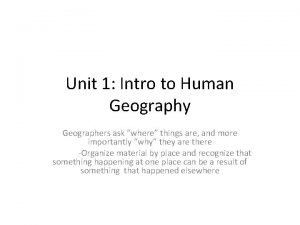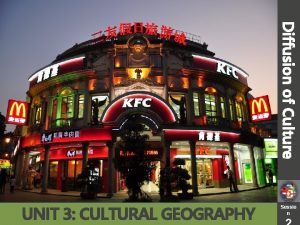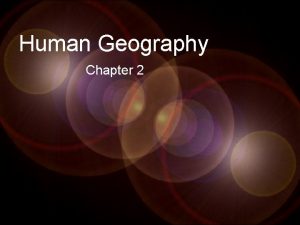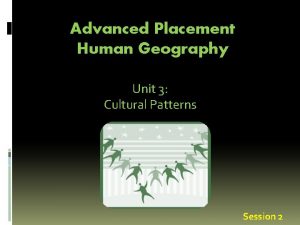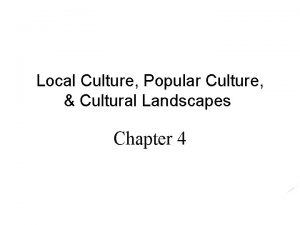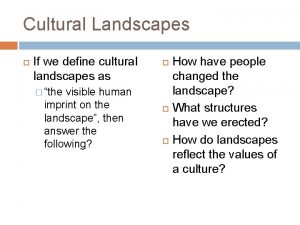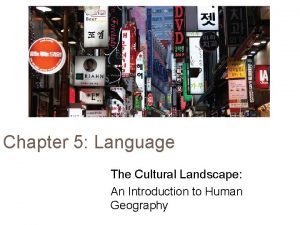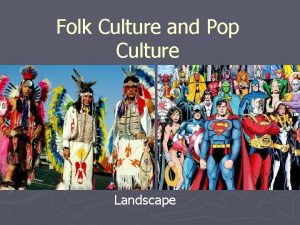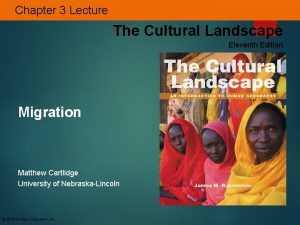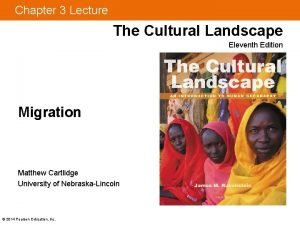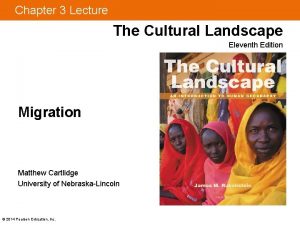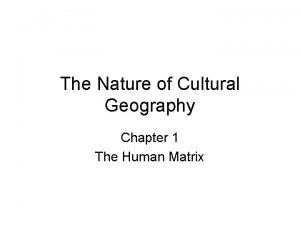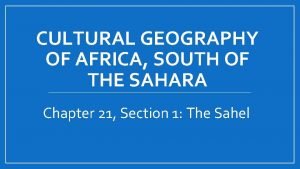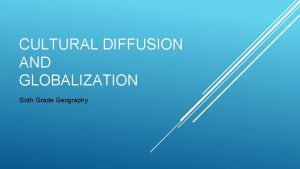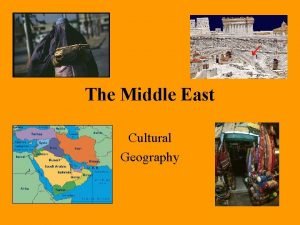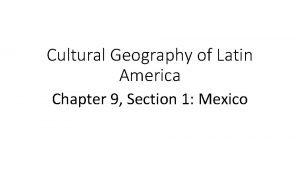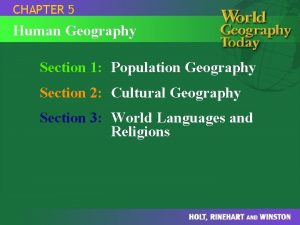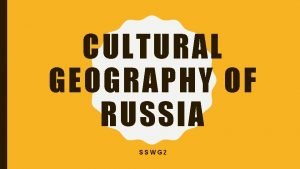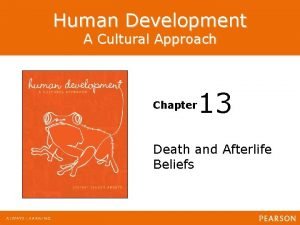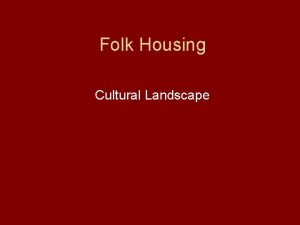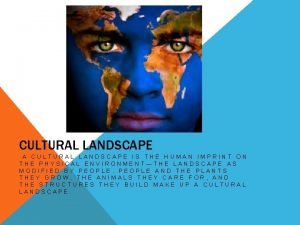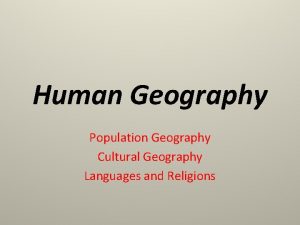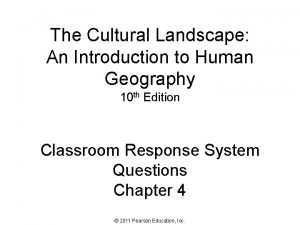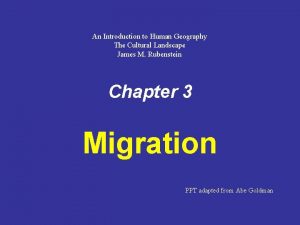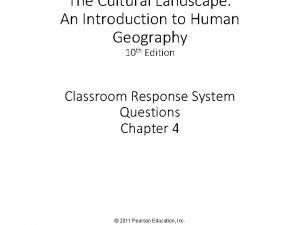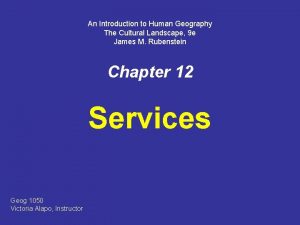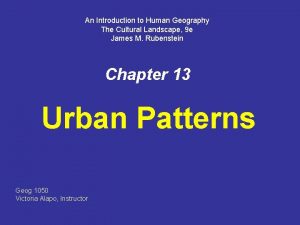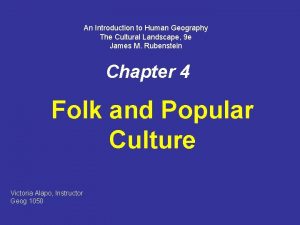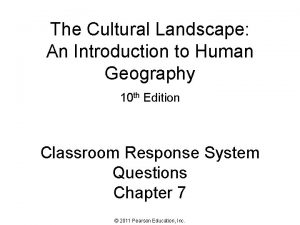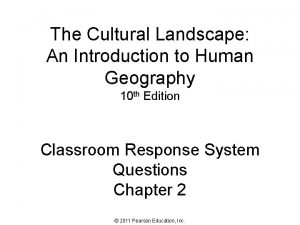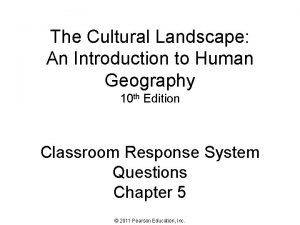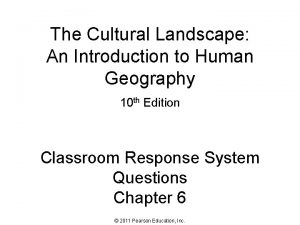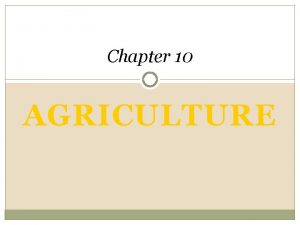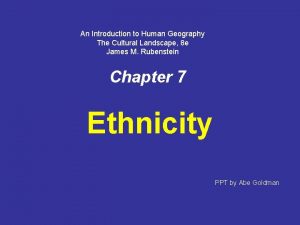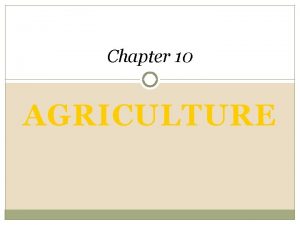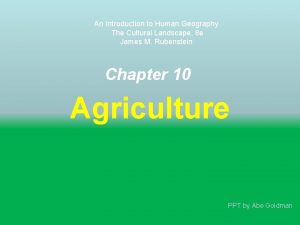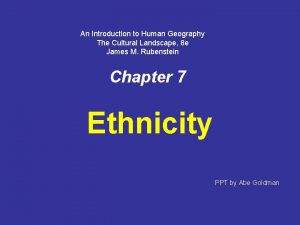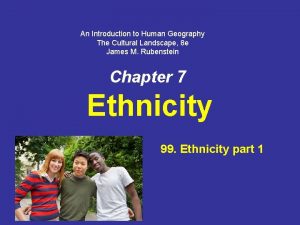An Introduction to Human Geography The Cultural Landscape















































- Slides: 47

An Introduction to Human Geography The Cultural Landscape James M. Rubenstein Chapter 4 Folk and Popular Culture (please read the chapter) PPT by Abe Goldman

What is culture? Over 200 definitions of culture Mariinsky opera house, St Petersburg Music and Art Andy Warhol

ALSO …. Artifact. . What we make Food we eat Music. . Sounds we make Way of life. . How we get around

Culture as the way we live

Culture as our traditions

What is culture according to others? • Many definitions! • Rubenstein: combination of values, material artifacts and political institutions (pg 114) • UNESCO "set of distinctive spiritual, material, intellectual and emotional features of society or a social group, and that it encompasses, in addition to art and literature, lifestyles, ways of living together, value systems, traditions and beliefs". United Nations Educational, Scientific and Cultural Organization (UNESCO) Its aim: to build peace in the world through knowledge, social progress, exchange and mutual understanding among peoples.

Cultural Geography • Involves study of everything about the way people live (what, why and where) – – – Clothes Diet Articles of material culture: artifacts Customs – patterns of behavior Interpersonal arrangements, family structure, educational methods – How we see ourselves: writing, photographs, paintings – What we collect (deem valuable) • Culture is linked to both group and personal identities

Folk and Popular culture • Folk: Traditional, small groups, general concentrated around a hearth, linked to an ethnic group, hand-made, culture changes slowly, resistant to change, sometimes a struggle to survive. • Popular or ‘pop’: large groups, rapid spread, reproduction from multiple sites

Looking at artifacts • Reflect aspects of the culture – – – What is it Where is it used Where did it originate from What is it made of Is it part of popular of folk culture What stories are attached to it

Culture is not static • Forces of cultural change – Evolution • change within a group over time (even folk culture) – Diffusion (more rapid and further in the case of popular culture) • adaptation of elements from another group • diffusion from a hearth (central area)

Folk Culture Ger (Yurt): Home for 50% of Mongolians: material culture, movement, city living

Popular culture

Folk vs popular culture • In general there is a concern about popular culture (Westernization) overwhelming folk culture. • What is lost with the spread of Westernization? • View of folk culture as constant and not economically viable. Is it constant, does it necessarily mean a lesser standard of living? • Economic value and folk culture

Culture Regions as having economic value tied to their unique identity • Champagne • Roquefort

Geographical Indication and Terroir • Geographical Indication (GI): a name or sign that corresponds to a particular location (European Law) • Terrior: beyond trade-mark type approach to a philosophy and awareness that foods taste different depending on where they come from (soil, climate, how it is grown, differences in varieties) • http: //www. chow. com/food-news/54681/oyster-varietals/

Economic and cultural survival: Folk culture moves into popular culture: Harris tweed: Scottish culture Survival of folk art by infiltration of popular culture markets Nike for $220.

Rugs as folk culture • Oriental rugs come from various sites, each with its own characteristics • Hand woven and hand knotted if it has pile Rug-making in Turkey

Folk culture becomes popular culture in another country High value items Imported from overseas and manufactured in the West (my office) Transculturation

Folk culture to popular culture: not new! Crystal Palace 1851 – World’s Fair (Queen Victoria, Products from the empire, Indian-British products) Transitional products, interest in material artifacts (start of British Museum) This fair marks the start of mass tourism, Thomas Cook excursions. Tourism is today part of popular culture

Folk culture still integrating into popular culture today Folk culture of Lavender cultivation, Provence

New folk culture of the Sequim, the selfproclaimed Lavender capital of North America, a blurry line between folk and pop culture

Transculturation: cultures mesh, sometimes mash? • Western and Islamic worlds • http: //www. ted. com/talks/lang/eng/shere en_el_feki_pop_culture_in_the_arab_w orld. html

Popular Culture • Culture of people who embrace innovation and conform to changing norms • Rapid diffusion • Mass culture – Food, clothing, items that are mass produced – “Mass taste” = loss of individuality • Geographic variation of market penetration • Marketing of popular culture (development of felt needs) • Uniformity of consumption, landscape

Consumption fuels popular culture • Development of felt needs • Felt needs • Attachment of a product to cultural commodity • Billions of dollars • “Ask for m? ”

Popular culture often results in uniform landscapes: Globalization of popular culture Mc. Donald’s in China Convenience Uniformity as a landscape element Bright Colors

Uniform landscapes: Resorts and recreation sites Environmental impacts

Tin Pan Alley and Popular Music • Diffusion of popular music from a hearth • Origin of popular music around 1900 • Music halls, vaudeville (fed into movies) • Irving Berlin • American popular music diffused worldwide in WWII Fig. 4 -2: Writers and publishers of popular music were clustered in Tin Pan Alley in New York City in the early twentieth century. The area later moved north from 28 th Street to Times Square.

Diffusion of Amish Settlements in the U. S. : a function of their culture Relocation as sons are given farms spreads this traditional (folk) culture Fig. 4 -3: Amish settlements are distributed through the northeast U. S.

Influence of the physical environment on folk cultures: Inuit – traditional food Asking for Food From Spirits by Elsie Klengenberg, Holman Island, 1989

Pacific Northwest Indians The Salmon Eaters by Ken Mc. Neil & Stan Bevan Tahltan-Tlingit

Traditional British food (Yikes!) – Climate – England, slow cooking, frying

Food Taboos Eating bugs in Thailand http: //news. bbc. co. uk/1/shared/spl/hi/picture_gallery/07/asia_pac_eating_insects_in_thailand/html/1. stm

Houses: an expression of culture • House as an essential concern of cultural geographers: What is a home, how homes are made through actions and physically with hammers and nails. • House as a basic right? • http: //www. un. org/en/documents/udhr/ • Product of cultural and physical environment • Houses as space under an individuals control: behaviors/traditions, belongings • Shopping carts to mansions

Houses: creating home Jon May’s study of homeless people in 2000 • Shelters • Possessions • Control over space • Alteration of space (minor to major) • Douglas Porter and Sandra Smith: Domicide

House materials: Environment • USA/Canada: Wood based (log cabins to new contemporary homes … changes) • US Southwest and other hot and dry countries: adobe • Britain: brick • Also other influences: style, builders experience, nostalgia/homesickness (once considered a disease)

Houses: Making homes spiritual • Cross on bedroom wall • Sacred walls/corners (Fiji, Parts of China) • Feng Shui: location and harmony Feng Shui Elements : -Wall colors represent fire and earth -Table and chair represent wood -Fountain and pillow are water elements -Sofa color is earth

Homes: Culture determines home locations in Southeast Asia Head as high and noble Heads toward the East, concern about spirits Fig. 4 -7: Houses and sleeping positions are oriented according to local customs among the Lao in northern Laos (left) and the Yuan and Shan in northern Thailand (right).

Houses over time: Diffusion of House Types in U. S. • Study by Fred Kiffnen • Pioneer homes reflected east coast styles at the time (can you say this was the popular culture of the times? ) Fig. 4 -9: Distinct house types originated in three main source areas in the U. S. and then diffused into the interior as migrants moved west.

U. S. House Types, 1945– 1990 Fig. 4 -11: Several variations of the “modern style” were dominant from the 1940 s into the 1970 s. Since then, “neo-eclectic” styles have become the dominant type of house construction in the U. S.

New homes … Popular culture but elements of folk culture Mix of styles Dreams for sale BUT regional differences still exist, eg PNW East Coast California

Culture and High technology Diffusion of popular culture through TV, 1954– 2003 • First in 1930 s • Blocked during the war • Rapid increase in number of televisions in the 1950 s • ¾ of US homes had televisions by end of 50 s Diffusion of what precisely? Fig. 4 -14: Television has diffused widely since the 1950 s, but some areas still have low numbers of TVs per population.

Distribution of Internet Hosts Fig. 4 -15: The U. S. had about one-third of the world’s internet hosts in 2000. Diffusion of internet service is likely to follow the pattern of TV diffusion, but the rate of this diffusion may differ. Note: This situation is cahnging very rapidyl

Television and Internet • What is the difference in the cultural impact? – Are these social activities? – Worlds in the television box compared to worlds within the internet? – Impact on popular culture? – Impact on folk culture?

Change in traditional role of women with change in culture • Role largely not like Queen Boudica (Boadicea) AD 60 • Geisha (sanitized subservience/human trafficking? )

Women in many traditional societies: lack of status • United Nations studies on women have concluded that although women have made some gains in education, health, employment and politics in the last decade, equal rights for women are still a long way off. Afghanistan Tanzania

Lower economic status: lower general status Lower general status: opening to abuse Selling mangos in India Gathering animal fodder in Nepal Global diffusion of women’s rights? Nobel Peace Prize 2011: http: //www. nobelprize. org/nobel_prizes/peace/laureates/2011/ HOPE: http: //actionaidusa. org/what/womens_rights/? gclid=CNP 8 o. Oy 1360 CFQi. Bhwod. J 10 GCQ

Before we finish: Our Individual Cultural Identities • Identity (who we are) • Identity as plural: how do we define ourselves? • What folk culture do we identify with? • What pop culture do we identify with? • What traditions have faded from our lives? • What traditions are we remaking?
 Middle atlantic folk house
Middle atlantic folk house Artifact example ap human geography
Artifact example ap human geography Perceptual region definition
Perceptual region definition 3 pillars of sustainability ap human geography
3 pillars of sustainability ap human geography Acculturation geography definition
Acculturation geography definition Cultural cohesion ap human geography
Cultural cohesion ap human geography Cultural homogenization ap human geography
Cultural homogenization ap human geography Example of linguistic fragmentation
Example of linguistic fragmentation Frq format ap human geography
Frq format ap human geography 5 themes of geography ap human geography
5 themes of geography ap human geography Ap human geography political geography test
Ap human geography political geography test Cultural landscape convergence
Cultural landscape convergence What is the meaning of cultural landscape
What is the meaning of cultural landscape Language cultural landscape
Language cultural landscape Threats to folk culture
Threats to folk culture The cultural landscape chapter 3
The cultural landscape chapter 3 The cultural landscape chapter 3
The cultural landscape chapter 3 The cultural landscape chapter 3
The cultural landscape chapter 3 Gni definition ap human geography
Gni definition ap human geography Cultural geography definition
Cultural geography definition Vocabulary activity 24 cultural geography of south asia
Vocabulary activity 24 cultural geography of south asia Vocabulary activity 15 cultural geography of russia
Vocabulary activity 15 cultural geography of russia The cultural geography of europe chapter 12 answer key
The cultural geography of europe chapter 12 answer key Cultural geography of africa
Cultural geography of africa Cultural diffusion definition geography
Cultural diffusion definition geography Ethnic groups in the middle east
Ethnic groups in the middle east Cultural geography of latin america
Cultural geography of latin america Example of cultural geography
Example of cultural geography Cultural geography of russia
Cultural geography of russia Cultural diversity a primer for the human services
Cultural diversity a primer for the human services Human development a cultural approach
Human development a cultural approach Hát kết hợp bộ gõ cơ thể
Hát kết hợp bộ gõ cơ thể Lp html
Lp html Bổ thể
Bổ thể Tỉ lệ cơ thể trẻ em
Tỉ lệ cơ thể trẻ em Chó sói
Chó sói Glasgow thang điểm
Glasgow thang điểm Chúa sống lại
Chúa sống lại Các môn thể thao bắt đầu bằng tiếng nhảy
Các môn thể thao bắt đầu bằng tiếng nhảy Thế nào là hệ số cao nhất
Thế nào là hệ số cao nhất Các châu lục và đại dương trên thế giới
Các châu lục và đại dương trên thế giới Công thức tính thế năng
Công thức tính thế năng Trời xanh đây là của chúng ta thể thơ
Trời xanh đây là của chúng ta thể thơ Mật thư anh em như thể tay chân
Mật thư anh em như thể tay chân Làm thế nào để 102-1=99
Làm thế nào để 102-1=99 độ dài liên kết
độ dài liên kết Các châu lục và đại dương trên thế giới
Các châu lục và đại dương trên thế giới Thơ thất ngôn tứ tuyệt đường luật
Thơ thất ngôn tứ tuyệt đường luật
